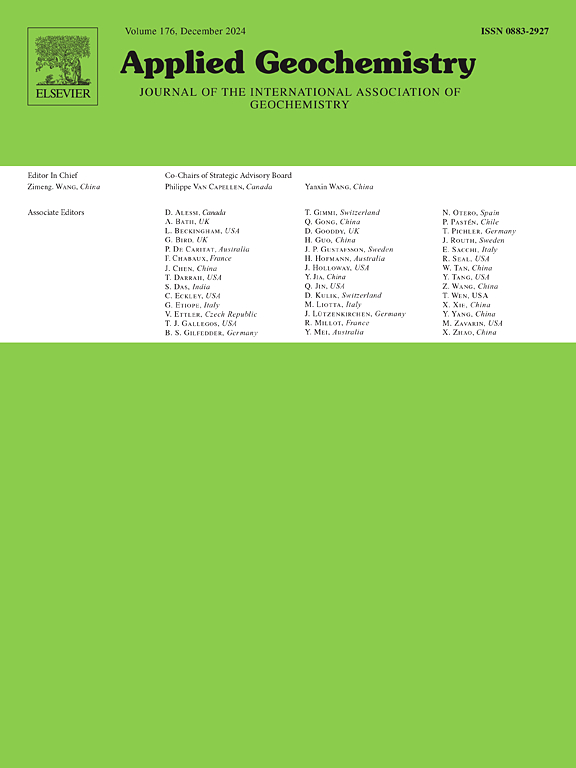印度拉贾斯坦邦北德里褶皱带Jahaz铀矿床蚀变变质沉积岩中的铀富集:全岩地球化学研究的推论
IF 3.4
3区 地球科学
Q1 GEOCHEMISTRY & GEOPHYSICS
引用次数: 0
摘要
Jahaz矿床赋存于印度拉贾斯坦邦北德里褶皱带中元古代变质岩中,是沿“钠长岩线”发育的na -交代铀矿床之一。本文介绍了少量至中度蚀变和脂化岩石的全岩主要、微量和稀土元素的地球化学分析,用于量化流体-岩石相互作用过程中化学成分的交换。蚀变箱形图显示蚀变强度(钠长石化、绿泥石化、钙化、绢云母化、黄铁矿化),推断蚀变岩中钠长石、绿泥石、方解石和绢云母的形成是Na-Ca-Mg-K交代作用的结果。利用主要的和选定的微量元素浓度(少蚀变到中等蚀变和钠化的石榴石石英黑云母片岩/角闪岩)构建了等距图,以确定岩石-流体相互作用过程中元素的净损失和增益。相关系数表明,在流体-岩石相互作用过程中,Zr、Nb、Hf、Ti等元素的流动性较弱。同位素分析结果表明,砷化石英黑云母片岩富集U、Na、Mg、Fe、Ca、Mo、Cu、Rb,富集K、Pb、Ba、Ni、Zn。钠长角闪岩富集Na、Cu、Mg、Cu、Y、Cr、Se、Ni、K、LOI,富集Ba、Co、Pb、Zn、Ca、P、Mn、Fe。钠化石英黑云母片岩Th/U比值较低,表明钠化岩富集铀。因此,Jahaz铀矿床中铀富集与钠、钼、铜、Th、Zr、LOI和轻稀土元素呈正相关。这些结果与乌克兰的Kirovograd和Novoukrainka、巴西的Lagoa Real、澳大利亚的Valhalla、中国的龙首山、圭亚那的ariicheng和美国的Coles Hill钠交代铀矿床相似。本文章由计算机程序翻译,如有差异,请以英文原文为准。
Uranium enrichment in altered metasedimentary rocks of Jahaz uranium deposit, North Delhi fold belt, Rajasthan, India: Inferences from whole-rock geochemical studies
Jahaz deposit is one of the promising Na-metasomatic uranium deposits along the “albitite line” and is hosted in the Meso-Proterozoic metamorphic rocks of the North Delhi Fold Belt, Rajasthan, India. This article presents whole-rock geochemical analyses of major, trace, and rare-earth elements of less to moderately altered and albitized rocks, which are used to quantify the exchange of chemical components during fluid-rock interaction. The alteration box plot indicates the intensity of alterations (albitization, chloritization, calcitization, sericitization, pyritization), and it is inferred that Na-Ca-Mg-K metasomatism was responsible for the formation of albite, chlorite, calcite, and sericite in the altered rocks. Isocon diagrams have been constructed using major and selected trace element concentrations of less to moderately altered and albitized garnetiferous quartz biotite schist/amphibolite to determine the net loss and gain of elements during rock-fluid interaction. The correlation coefficients indicated that elements such as Zr, Nb, Hf, and Ti were less mobile during fluid-rock interaction. Isocon analyses show that the albitized garnetiferous quartz biotite schist is significantly enriched in U, Na, Mg, Fe, Ca, Mo, Cu, Rb, and depleted in K, Pb, Ba, Ni, Zn. Albitized amphibolites are enriched in Na, Cu, Mg, Cu, Y, Cr, Se, Ni, K, LOI and depleted in Ba, Co, Pb, Zn, Ca, P, Mn, Fe. The low Th/U ratio of albitized garnetiferous quartz biotite schist indicates that the albitized rocks are significantly enriched in uranium. Hence, uranium enrichment is positively correlated with Na, Mo, Cu, Th, Zr, LOI, and light rare-earth elements of albitized garnetiferous quartz biotite schist/amphibolite in the Jahaz uranium deposit. These results are similar to Kirovograd and Novoukrainka (Ukraine), Lagoa Real (Brazil), Valhalla (Australia), Longshoushan (China), Aricheng (Guyana) and Coles Hill (USA) Na-metasomatic uranium-deposits.
求助全文
通过发布文献求助,成功后即可免费获取论文全文。
去求助
来源期刊

Applied Geochemistry
地学-地球化学与地球物理
CiteScore
6.10
自引率
8.80%
发文量
272
审稿时长
65 days
期刊介绍:
Applied Geochemistry is an international journal devoted to publication of original research papers, rapid research communications and selected review papers in geochemistry and urban geochemistry which have some practical application to an aspect of human endeavour, such as the preservation of the environment, health, waste disposal and the search for resources. Papers on applications of inorganic, organic and isotope geochemistry and geochemical processes are therefore welcome provided they meet the main criterion. Spatial and temporal monitoring case studies are only of interest to our international readership if they present new ideas of broad application.
Topics covered include: (1) Environmental geochemistry (including natural and anthropogenic aspects, and protection and remediation strategies); (2) Hydrogeochemistry (surface and groundwater); (3) Medical (urban) geochemistry; (4) The search for energy resources (in particular unconventional oil and gas or emerging metal resources); (5) Energy exploitation (in particular geothermal energy and CCS); (6) Upgrading of energy and mineral resources where there is a direct geochemical application; and (7) Waste disposal, including nuclear waste disposal.
 求助内容:
求助内容: 应助结果提醒方式:
应助结果提醒方式:


